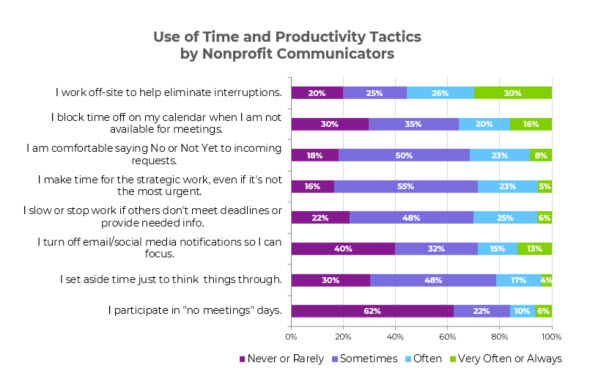
It’s one of the most common complaints we hear from nonprofit communicators: I don’t have enough time to do all this work.
Our Problem with Not Having Enough Time
But, of course, we all get the same number of hours in a day. It’s not that you need more time; it’s that you need fewer things to do in the time you have.
But we also know that if you work in nonprofit communications, 99% of the time, you’ve been asked to do too much (or have agreed to do too much or have too many great ideas on your own). Too many tasks and tactics, minimal planning and forecasting, and lackluster attempts at prioritization are endemic in nonprofits. This creates a multitude of challenges for communications staff.
It would be nice if all that communications staff needed were more training in time management and personal productivity. But it’s simply not true.
Instead, nonprofit communicators need a more sophisticated approach to the way they think about time and how to get the important work done – and frankly a lot of urgent, but not important work done too – all within the limited number of hours they are paid for.
I’m working on a new webinar we’ll premiere on May 5 called Peaceful Time Management and Productivity for Nonprofit Communicators. It was important to me to include the word peaceful in the title because so much productivity advice is actually the opposite and very anxiety-producing (You must get up at 4 am! You must use this kind of software! If you aren’t getting all the things done, it’s your fault! All of that is bullshit.).
Some Different Approaches That Can Help
Our CALM not BUSY framework is meant to help in many ways. We urge you to manage your communications for CALM by being Collaborative, Agile, Logical, and Methodical. We urge you to avoid the BUSY in your work: the tasks, conversations, and approaches that are Bogus, Unrealistic, Sidestepping, and Yoked.
We also get specific about different things you can try. In the 2022 Nonprofit Communications Trends Report, we asked nonprofit communicators how often they used different tactics known to help people feel more in control of their workloads, time, and productivity.
Of the tactics listed in the survey, “working off-site to help eliminate interruptions” was used most often, followed by “blocking time off in the calendar when I am not available for meetings.” We suspect “working off-site” got a huge boost due to the pandemic, but we didn’t explicitly ask if that was the case.

When we asked which of the tactics on the list was most important, however, two different answers rose to the top. First was “being comfortable saying no or not yet to incoming requests,” followed by “making time for strategic work even if it’s not the most urgent.”
The Amount of Time Spent on Various Activities in an Average Week
We also asked survey participants to categorize how much time they spend on a handful of different tasks.
From the choices we provided, “time in internal meetings” topped the list with 26% of survey participants stating they spend up to 16 hours or more each week in internal meetings!
The next most time-consuming task on the list was “reviewing and editing content created by others” with “social media content creation and management” coming in third.
We also asked what else takes more than four hours a week and the top answers were general content creation and writing, managing email inboxes, and managing staff.
What we see too much of in these responses is what author Cal Newport calls “shallow work” as opposed to “deep work.” Time for deep work – the higher-priority, meaningful work that comes from focusing without distraction on important tasks for longer periods of time – is what nonprofit communicators desperately need more of.
We’ll continue to explore that here on the blog and in our training and coaching programs.





